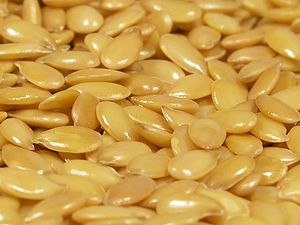| (Photo credit: Wikipedia) |
* Severe pain on one or both sides of your head
* Pulsating or throbbing pain
* Nausea and/or vomiting
* Sensitivity to light and/or sound
* Extreme fatigue
* Headache pain lasting from several hours to several days
While there are millions of sufferers, many people do not want to take pharmaceuticals because of the expense, side effects, and potential risks. Not to mention that many drugs don't even really help all that much with migraines. The good news is there are several natural remedies for migraines. Let’s take a look at eight ways of treating migraines naturally:
1. Feverfew, an herb, is commonly used as a treatment for migraine, arthritis and fever. It has been shown to cause a significant decrease in migraine frequency among sufferers. Unfortunately, as is the case with many herbs, there can be side effects including stomach distress and a possible interaction with blood-thinning medications, so be sure to check with your doctor before taking this.
2. 5-HTP, or 5-Hydroxytryptophan, a compound produced in your body from the amino acid tryptophan, is used to make serotonin and melatonin. You can also consume it in supplement form. It has been studied for its ability to reduce the severity and duration of migraines.
3. Magnesium, a mineral naturally found in many foods including greens, nuts, seeds, and whole grains, has been studied for its ability to reduce the frequency of migraines in sufferers. However, high doses of magnesium may cause stomach distress, muscle weakness, difficulty breathing, low blood pressure, irregular heart rate, and it can interact with some medications. Many people are actually deficient in magnesium, so taking a fair amount wouldn't hurt, and could help with other deficiency conditions as well - but you'll want to check with your doctor and get a blood test before taking any large doses. Small doses of 500-250 mg should be quite safe for most people.
4. Butterbur, an herb, has been studied for its ability to prevent migraines and it has very few side effects or interactions. However, if you’re allergic to ragweed then skip the butterbur because they’re in the same family. You can consume butterbur in tea and extracts and capsule form.
5. Vitamin B2. Studies have shown a great reduction of migraines in people who take riboflavin for at least three months, and women who suffer from menstrual migraines seem to receive a significant benefit.
| Flax seeds (Photo credit: Wikipedia) |
7. Acupuncture has been used to treat migraine/headache successfully for many years. Not all practitioners are created equal. Make sure you have a licensed therapist and be sure you’re comfortable with needles.
8. Biofeedback, guided imagery and relaxation techniques are also highly recommended by many migraine experts to not only help with pain relief and reduction, but to also begin to recognize early on when a migraine is pending so you can stop it in its tracks.
The causes for migraines are numerous and mysterious. One way to try to begin to determine the cause or causes for your migraines is to keep a migraine journal. Often people find that certain foods are migraine triggers. If you suffer from migraines, make sure you eat a nutritious balance of foods, get plenty of sleep and exercise regularly. These simple steps, in addition to natural migraine treatment, may have you migraine free in no time.



No comments:
Post a Comment